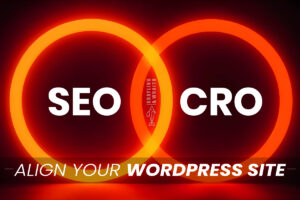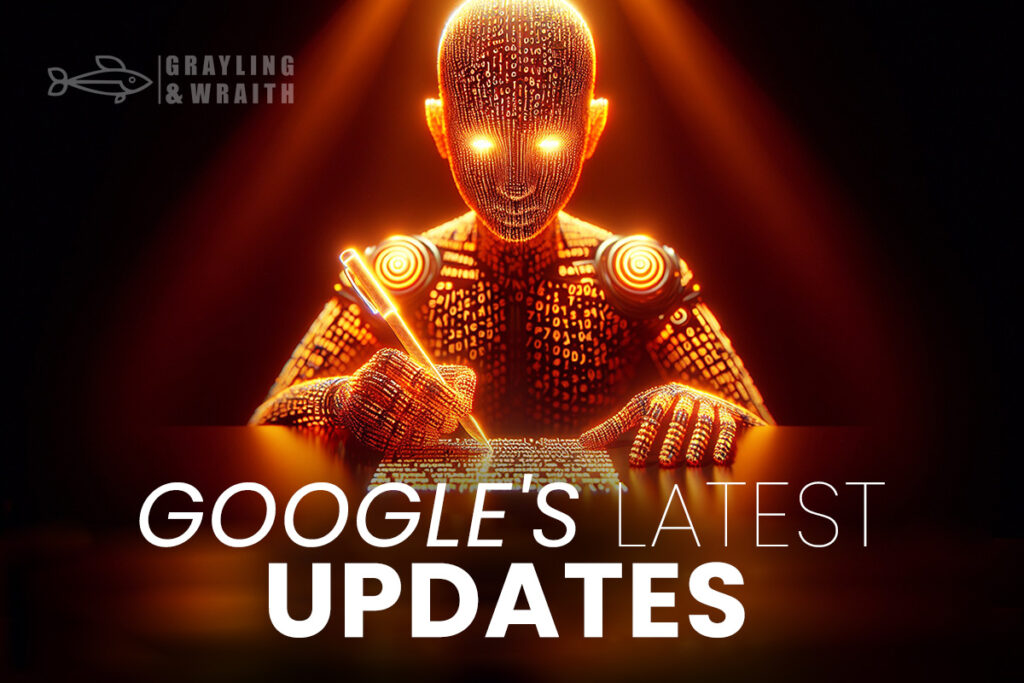Unlock your brand’s potential with a strategic approach to Organic Social Media.
It’s 2024, and you’re the proud owner of a quaint bakery, renowned for its mouthwatering array of baked delights. Despite the undeniable appeal of your confections, they remain a hidden gem, known only to a select few. Your Facebook presence barely garners any engagement, with your delicious cupcakes going unnoticed. Meanwhile, your Instagram has been silent for the past couple of months, with no new posts to draw in the crowds. Despite offering treats that are both scrumptious and reasonably priced, public interest seems lacking.
So, what’s missing here? The answer lies in your approach to Organic Social Media content.
In today’s digital age, a robust social media presence isn’t just for the big players. Small businesses like yours also need a well-crafted organic social media strategy to capture the right audience, unlock valuable insights, and elevate your brand’s visibility.

Why Use Organic Social Media for Business?
As of 2024, social media is bustling with activity, with billions of users logging in daily. Imagine, just a few years ago in 2022, there were 4.62 billion social media users, and the numbers have only grown since then. Every day, people spend hours scrolling, liking, and sharing. This isn’t just idle time; it’s a golden opportunity for businesses like yours.
Social media is your gateway to reaching out far and wide, to people from all corners of the globe. It’s where you can share your story, showcase your products, and engage with your audience in real-time, especially through Organic Social Media efforts. This isn’t just about posting updates; it’s about building relationships. When you connect with your audience on social media organically, you’re not just boosting your visibility. You’re laying the groundwork for increased sales, customer loyalty, and word-of-mouth referrals.
But here’s the catch: success on social media isn’t guaranteed just by showing up. Your content needs to resonate with your audience. It must be engaging, valuable, and, above all, consistent. The stakes are high, with nearly half of consumers ready to unfollow brands that don’t meet their expectations. And once you’ve captured their attention through Organic Social Media strategies, the rewards can be significant. A majority of your social media followers will not only visit your website but are also likely to become your customers and even recommend you to others.
Navigating the Digital Noise: Crafting an Authentic Social Media Presence
In a world drowning in digital content, where the average attention span is shorter than ever, making a lasting impression is challenging. You’re not just competing with other businesses but also against the endless stream of online content vying for your audience’s attention.
With the digital universe expanding at an astronomical rate, standing out requires more than just being present. You need a compelling, authentic social media presence that makes people want to engage with your brand.
So, how do you become that brand that everyone wants to follow and interact with? The secret lies in a strategic, well-thought-out social media plan, especially one that emphasizes Organic Social Media growth and engagement.
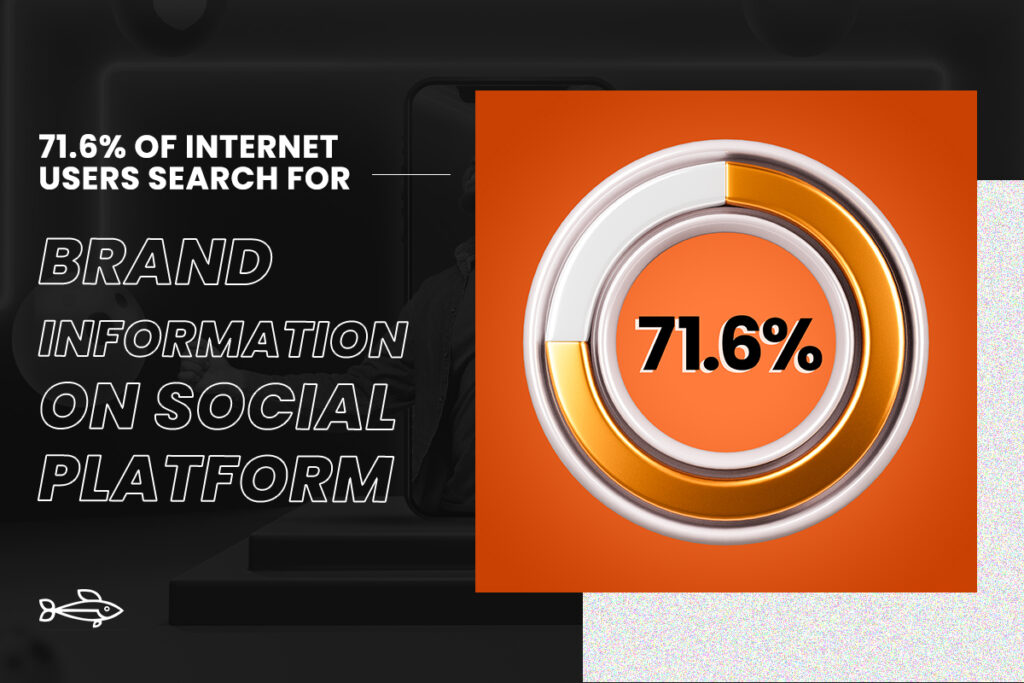
71.6% of Internet Users Search for Brand Information on Social Platforms
You could be losing revenues and missing out on potential customers and growth opportunities if your small business isn’t leveraging Organic Social Media. People are increasingly relying on social platforms to research products and services they want to purchase. For instance, 70% of viewers make purchases from a brand after seeing it on YouTube. When done right, Organic Social Media can be a cost-effective way of conveying your brand messaging to your target audience.
Defining Brand’s Content Strategy
Before we delve into the nitty-gritty of developing an effective social media marketing content strategy, let’s first define what Organic Social Media content strategy entails.
We all understand the concept of content, but when asked to define it precisely, it can become perplexing. After all, content can encompass various forms such as blogs, press releases, captions, Instagram Reels, or TikTok videos. In the realm of digital marketing, content typically comprises four core components:
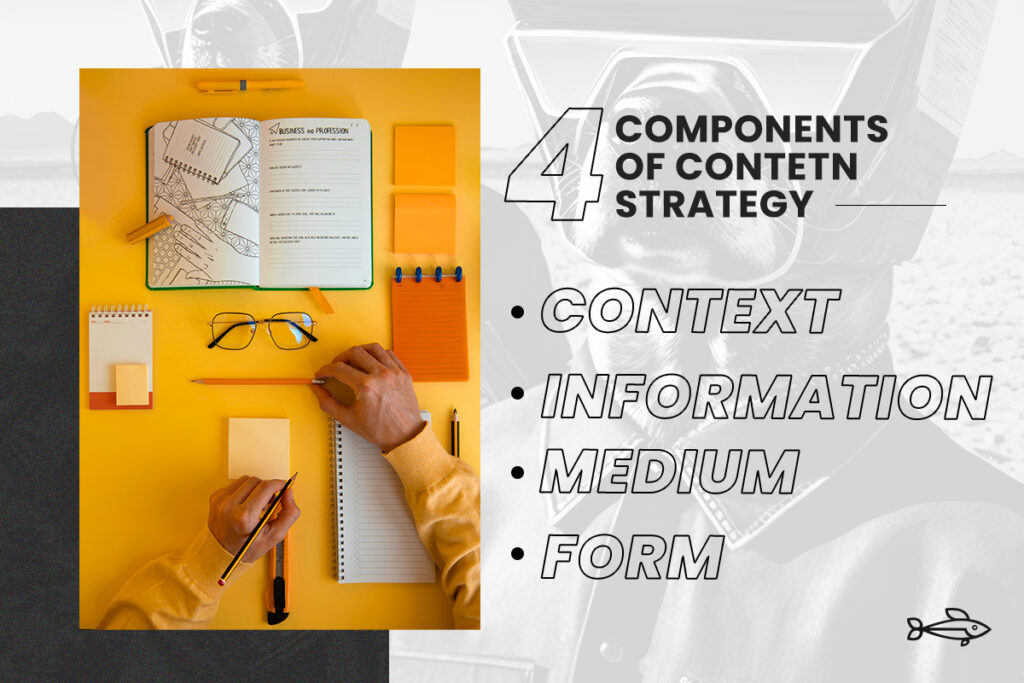
- Context – It is the positioning of content, purpose, or storyline that gives value to the audience. Context refers to the purpose of the content and its target audience.
- Information – This can be factual, informative, entertaining, practical, or a combination of everything.
- Medium – What platform are you using to produce your content and how will it impact your overall message?
- Form – The content can be texts, graphics, videos, audio, etc.
Most content definitions heavily revolve around information without really delving deeper into other components. Information without form and medium can get lost in translation, whereas information without context is irrelevant. Hence, these four elements should tie up together for persuasive or effective Organic Social Media content.
Digital content enables potential customers to discover and interact with your brand organically. As they search for topics related to their interests, they stumble on your content and get curious about your brand. Ultimately, it’s your content, particularly on Organic Social Media platforms, that solves your audience’s problems, entertains them, or helps them learn something new. Content is a means of displaying your expertise and awareness around the topics that your target audience cares about. It is an effective way to establish trust so if they decide to make a purchase, you are on their mind.
What is the Brand’s content strategy?
v A comprehensive content strategy goes beyond merely uploading a blog, crafting an editorial calendar, or posting content on social media platforms. It involves meticulous planning, seamless implementation, strategic promotion, and ongoing content management tailored to achieve your business goals. When executed effectively, your content strategy, including Organic Social Media initiatives, becomes the backbone of driving traffic to your website, generating leads, enhancing engagement, boosting sales, and fulfilling other crucial business objectives. Without a well-defined content strategy, you’re essentially herding cats, producing content based on assumptions rather than grounded data. Consequently, at the culmination of your campaign, you’ll find yourself unable to track progress or measure success accurately.
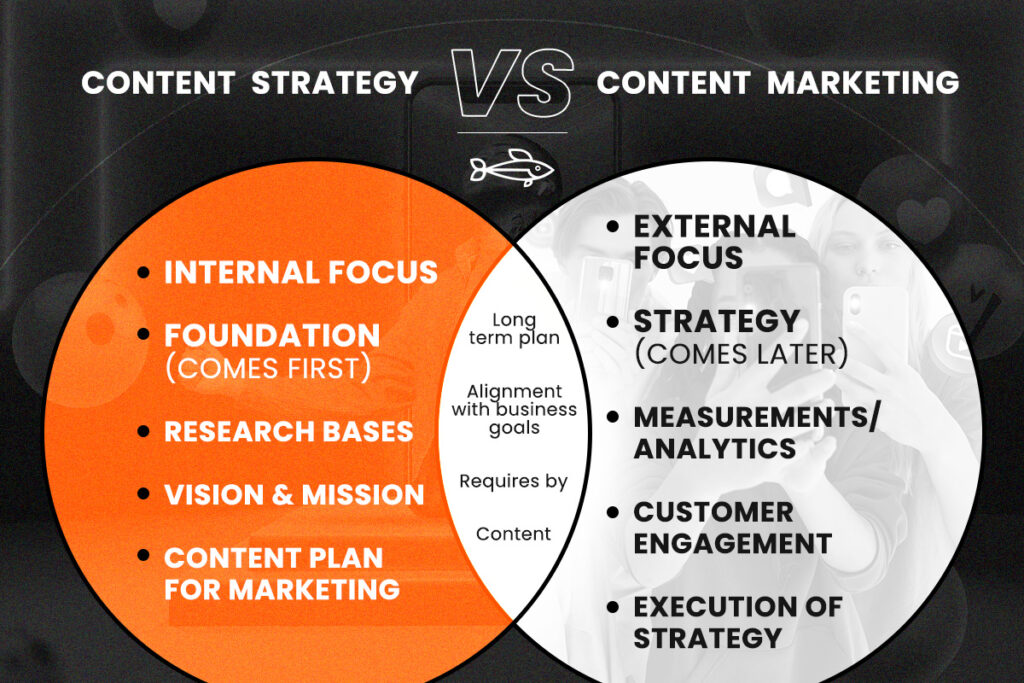
Content Strategy vs Content Marketing
Content strategy and content marketing go hand in hand, much like a cake on a plate. These terms are often used interchangeably, yet they represent distinct concepts. By understanding the difference, you provide clarity on content creation and distribution, setting boundaries for both content marketers and content strategists.
Your content strategy, particularly in the realm of Organic Social Media, establishes the why and how of every piece of content you produce. It serves as the guiding framework for content creation and distribution. Content marketing, on the other hand, encompasses the processes involved in creating and promoting these pieces of content. It guides the production, distribution, and management of relevant content.
In essence, a content strategy ensures that you are on the right track with your content marketing efforts, particularly in the context of Organic Social Media. It prevents you from wasting time producing content that your audience may not consume or that may not align with your business goals.
Building a Strategic Content Framework: Essential Considerations for Success
Every content strategy starts with establishing business goals. Without business goals, you are just producing content. Once you’ve established your goals, the following will help you figure out the how of your strategy:
- What are the types of content to produce that align with your business goals?
- What are the KPIs for the pieces of content you create?
- Who is your target audience for each content?
- What is the state of your content based on your website content audit?
- How will you generate content ideas that resonate with your brand voice, goals, and audiences?
- What type of content can your team produce best? Perhaps your team is great with short videos but this content type doesn’t translate well with your audience. This way, you have an idea of which types you should focus on more.
- How will you promote content to which platforms? Your brand doesn’t have to be everywhere, it just needs to be in channels that matter.
- How will you establish a seamless and reliable content system that doesn’t rely on impromptu requests?
Of course, it will take more than answering these questions to come up with a solid content strategy but they should help you get started. Your content marketing strategy must support your business goals, brand strategy, and marketing objectives.
Importance of Organic Social Media Content Strategy
Your brand will get lost in the sea of cutthroat competition without a content strategy. Essentially, writing content is shooting in the dark if you don’t have a well-defined strategy. Furthermore, without knowing the content to produce, target audience, or distribution channel, you’re producing content that doesn’t convert.
“A B2B Content Marketing, report revealed that while almost 80% B2B marketers report having a content marketing strategy, only 43% have documented their strategy.”
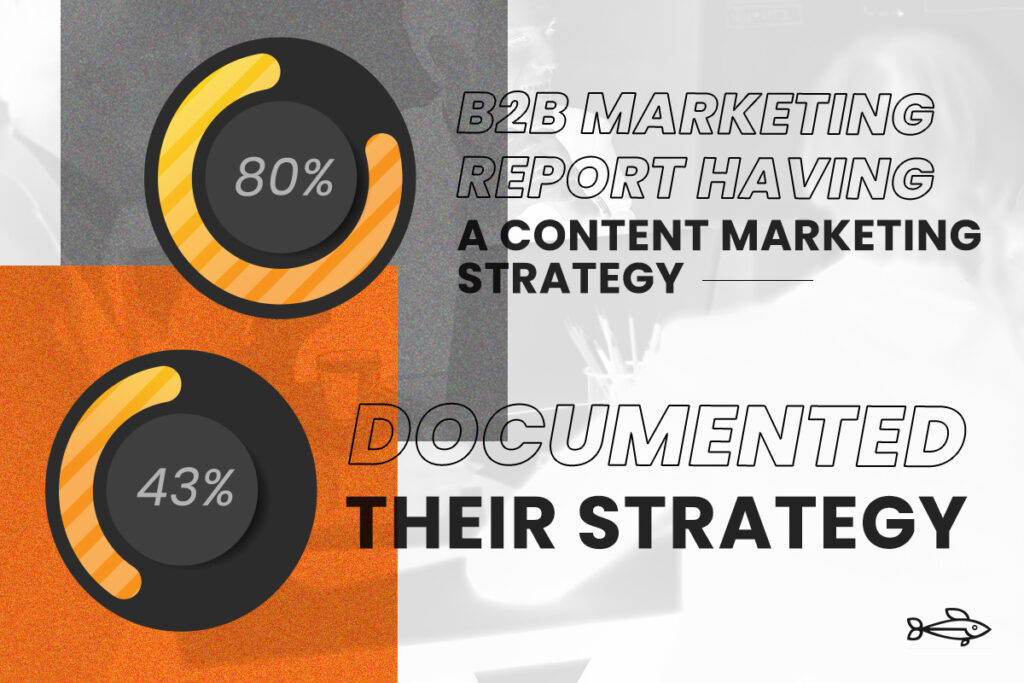
Importance of Organic Social Media Content Strategy for Your Business
Although it is essential for any business, not all content marketers and businesses have emphasized Organic Social Media content strategy. A B2B Content Marketing report revealed that while almost 80% of B2B marketers report having a content marketing strategy, only 43% have documented their strategy. That means that most marketers are winging their campaigns as they go or are flying blind. The lack of strategy sets brands apart as it differentiates whose brands have cohesive and coherent content that resonates with their audience.
The why of your content should come first before the “what”. Establishing a content strategy can be overwhelming for these possible reasons:
- You need to produce plenty of content
- There’s not enough time to overhaul your entire content
- You don’t know where to start
- You already know your audience and what they want
Your audience’s needs evolve so should your content strategy. With an excellent content strategy, you can:

Have a content system and direction
Are you stuck with what to write for this week on your Organic Social Media platforms? Do you have any idea of what content format you need to share on your social media channels? It becomes easier to brainstorm content ideas and topics when you know your “why”. When you document your Organic Social Media strategy, you see potential issues and visualize your entire content system. It enables you to make data-driven decisions as you see your content direction.
Improve quality and consistency
You provide clarity, consistency, and ultimately quality when you have a documented Organic Social Media content strategy. Having a lot of irrelevant, random content pieces on different social media channels will only mislead your audience. So is posting at inconsistent and random times. When you have a clear schedule for Organic Social Media content creation and distribution, you meet your readers’ expectations. Notably, content marketers have been overhauling their Organic Social Media content marketing plans and adjusting their content schedules. Content Marketing Institute shares that 58% of B2B marketers say they always or frequently deliver content consistently on a defined, regularly scheduled basis.
Identify New Opportunities
You can produce content around current topics that help reach more audiences and generate traffic to your website with a content strategy. Moreover, as a marketer, you constantly look for new content production opportunities that will support your business goals. For this to work, your content strategy should enumerate all the places that your team can use to find stories and news beats they can use to produce fresh content. Additionally, the effort to find new content becomes disorganized and uncoordinated without a well-crafted strategy. However, Organic Social Media can serve as a vital platform within this strategy, providing a channel for distributing timely and relevant content to engage with your audience effectively.
Optimizes your content and marketing team
Communication and accountability are crucial for successful content marketing. With a documented strategy, everyone on your team knows exactly what content to create, how much content you need to produce, where to post them, and when to post them. It establishes a work schedule for content production and distribution, guidelines on social media management, and everything in between. You can test your ideas and hypotheses, plan and schedule deliverables, track progress, and sustain momentum. It also sets out performance KPIs for your team members, including metrics specific to Organic Social Media initiatives.
Save resources and budget
When marketers operate without a strategy, they can spend too much on projects that don’t convert. Creating and distributing content can be costly, but with a content strategy in place, you can plan well ahead of time and determine the best way to maximize your resources. Content strategies help determine how much money you must spend on a project and how it should be spent. You can also justify your budget when needed.
Positions your brand as an authority
If executed properly, a content strategy places your brand at the center of your industry. You develop trust and credibility when you craft the right content for the right audience. Part of a content strategy is understanding your audience’s needs and solving their problems through your content. With content that builds your brand as an expert in your niche, you can become the go-to person in your industry.
Conveys your brand story
The way your brand is seen by your target audience is crucial for your business. Having a sensible strategy that will guide your content creation and distribution can help you communicate your culture, goals, mission, and your overall brand. You can articulate what and who you are to your audience with a clear strategy.
Quality of a Content Strategy
Having a content strategy doesn’t necessarily guarantee success. A lot of marketers struggle to implement their strategies and see actual results. A good content strategy should be:
- Customized to your goals – Having a content strategy that doesn’t meet your goals is worse than having no strategy. It is counterproductive to produce and distribute content that isn’t serving your target audience or larger goals.
- Extensive – The whole point of establishing a content strategy is to foster a lasting relationship with your audience through consistent, relevant content. Ultimately, this can be achieved through building a seamless content system and editorial calendar of interesting and engaging topics.
- Versatile – A content strategy is a roadmap that isn’t set in stone. You should be able to adjust your strategy when trends change or the unexpected happens.
around your capabilities, and designed to help you tell the best stories possible.
The key here is understanding your business goals, messaging, brand identity, target audience, etc., and ensuring that everyone on your team is on the same page. The best content strategy is aligned with your brand, built around your skills, and crafted to help you convey your brand to your audience.

Components of a Successful Content Strategy with Organic Social Media
Content is the currency of digital marketing. When done right, you are rewarded with your audience’s attention. However, simply producing content without goals doesn’t cut it. So, what do you need in place to start planning and producing content systematically? Whether you are overhauling your strategy or building a new one for your brand, here’s what you’ll need to get started, including a focus on leveraging Organic Social Media channels effectively:
Marketing goals
You wouldn’t be able to see actual results without well-defined goals. Avoid the temptation of having a lot of goals else you won’t see enough impact in your content marketing. Narrow down your goals to no more than three high-level content marketing goals. The most common content marketing goals include:
- Create brand awareness.
- Improve brand recognition
- Introduce your product/service
- Nurture your current audience
- Re-engage a previous audience
- Generate traffic
- Acquire customers
- Improve repeat sales from previous customers
- Widen market
- Increase referral traffic
- Attract better talent to your team
- Customer research and development
- Grow a list of brand ambassadors and affiliates
Depending on what your business needs, you will have varied KPIs and goals for your content strategy. Once you figure out your goals, you can determine your metrics to track your progress.
Brand Guidelines for Organic Social Media
Without brand guidelines, there will be a disconnect in your messaging, brand voice and tone, and language. This holds especially if multiple people or teams are working on behalf of your brand on Organic Social Media. You need to ensure that everyone on your team has a clear understanding of your brand story, personality, voice, etc. Establish your brand guidelines and document them for consistent branding across all Organic Social Media platforms.
Audience Personas for Organic Social Media Engagement
Content marketing is meant to reach people, be it from a broadly defined group or a narrower segment of a specific demographic, especially on Organic Social Media. An audience persona represents your target audience. Each audience persona should have a short description of themselves such as their age, gender, location, education, family status, household income, job role, etc. You must also document their cultural and behavioral traits including consumer needs, fears, pain points, purchasing frictions, media preferences, and personal goals.
At every chance you get, your goal is to learn more about your customers, including those engaging with your brand through Organic Social Media. You can get these details from surveys, sales calls, interviews, and interactions on social media platforms. It’s inevitable to have an unexpected audience who may bring value to your business, particularly through Organic Social Media channels. Work on uncovering deeper insights about them that oftentimes marketers overlook. This will help you provide more customized content that your audience can relate to.
Data and Marketing Research for Organic Social Media Strategies
Research and data will provide valuable customer insights and an understanding of your competition, crucial for shaping effective Organic Social Media strategies. You can gather information from sales data, surveys, customer feedback, website traffic, social media interactions, and third-party data. Part of your research should also include analyzing your competitors on Organic Social Media platforms. Understanding your competition enables you to spot opportunities to rise above and fill any gaps that your market may have overlooked.
Mapping Customer Journey on Organic Social Media
Your audience persona isn’t absolute, especially when considering their behavior on Organic Social Media. The same customer persona will have different needs and will be seeking different data based on where they are in their customer journey. Customer journey mapping on Organic Social Media involves understanding the steps your audience takes during the buying decision process on these platforms. It’s how you turn visitors into customers. To tailor-fit your content for Organic Social Media, you need to understand where your customers are at in their journey on these platforms. Doing so will capture the right attention and generate targeted leads. Buyer persona and customer journey mapping are something you need to update constantly and refine for customized content and customer experience on Organic Social Media.
SEO-focused
Incorporate SEO best practices to attract traffic and build content that your target audience is searching for. Furthermore, content marketing allows you to produce a sustainable source of organic traffic from search engines. By optimizing keywords that your audience uses, you can produce targeted content. Moreover, look for these keywords in forums, Q&As, reviews, search queries, and user-generated content. Additionally, these keywords are likely aligned with the solutions and products that you offer.
Choose the right platforms
Your brand doesn’t have to be on all platforms, it just needs to be where your audience is active. But, how do you know which ones are right for your business? Research and understand how each social network operates. Find the platforms where your audience is most interactive. Analyze your competition and evaluate which platforms they are using. Once you figure out these platforms, assess your resources. Are you capable of providing content for these channels?
Build a content library
The road to a successful social media campaign is long and hard but you don’t have to sweat the small stuff. Not all you post online should be original. Generating engaging and interesting content can be time-consuming. There are days when you are strapped for time and your creative juices run dry.
This is where a content library becomes helpful. By having a content library, you can pull out content from various sources anytime. Additionally, review your offline marketing collaterals, and think of creative ways to feature them online. Furthermore, curate content from relevant sources that align with your audience’s interest. Examples of curated content include sharing a link to a blog post, quotes from industry experts, or even resharing someone else’s social media post. You can also reshare your followers’ posts as part of your community engagement strategy.
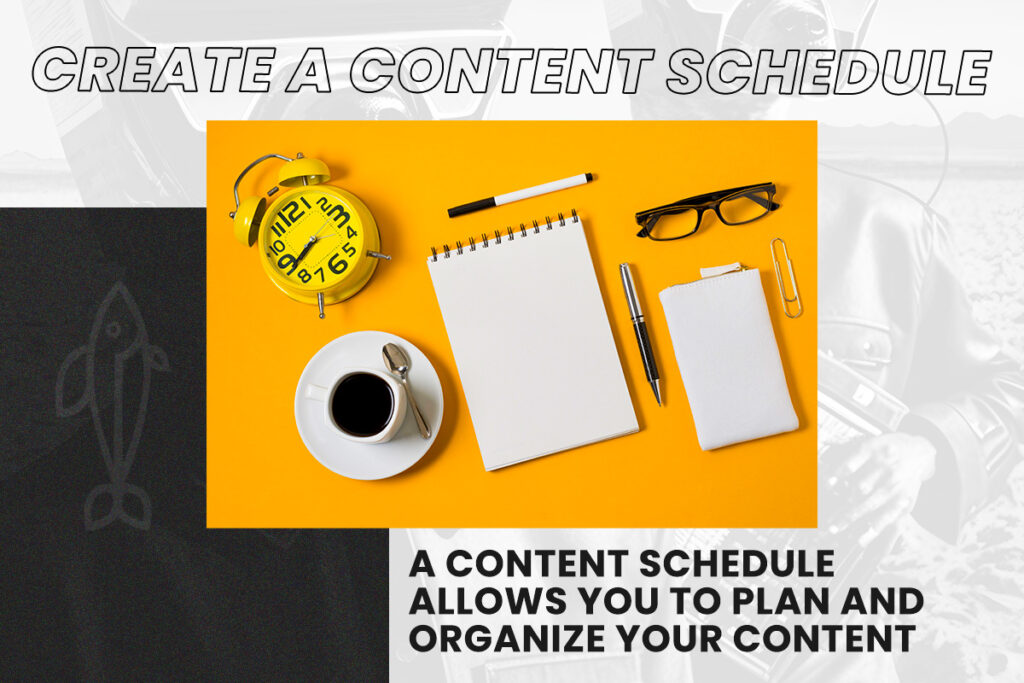
Create a content schedule
A content schedule allows you to plan and organize your content. You can post and show up in your audience’s timeline consistently through a social calendar. With consistency comes engagement that can increase your organic reach. Planning your posts saves you from typographical errors and grammar mistakes. To guide you with your content calendar, consider these steps:
- Audit your social channels and content
- Choose your social platforms
- Consider what your calendar needs to track
- Come up with a content library
- Create a workflow
- Start producing posts
- Review your calendar with your team and use their feedback for improvement
- Start scheduling and posting
A content schedule allows you to plan and organize your content. You can post and show up in your audience’s timeline consistently through a social calendar. With consistency comes engagement that can increase your organic reach. Planning your posts saves you from typographical errors and grammar mistakes. To guide you with your content calendar, consider these steps:
Use social tools
Consider tools to stay on top of your game and keep track of your progress. There are a plethora of social media tools available that will ensure a seamless content system and workflow and support your social campaigns. Tools for content curation, discovery, scheduling, posting, and analytics not only make things efficient, but they can also provide insights you can use to finetune your campaigns.
Set up your analytics
Social media analytics allow you to track your progress, and figure out which strategy works and which tactics you need to put on hold. It also helps you create performance reports to see the bigger picture and assess your strategy on macro and micro levels. Navigating analytics can be daunting since each platform has different metrics you’re able to track. The best way to approach this is to review your social goals. These goals will help you determine which metrics you need to keep an eye on.
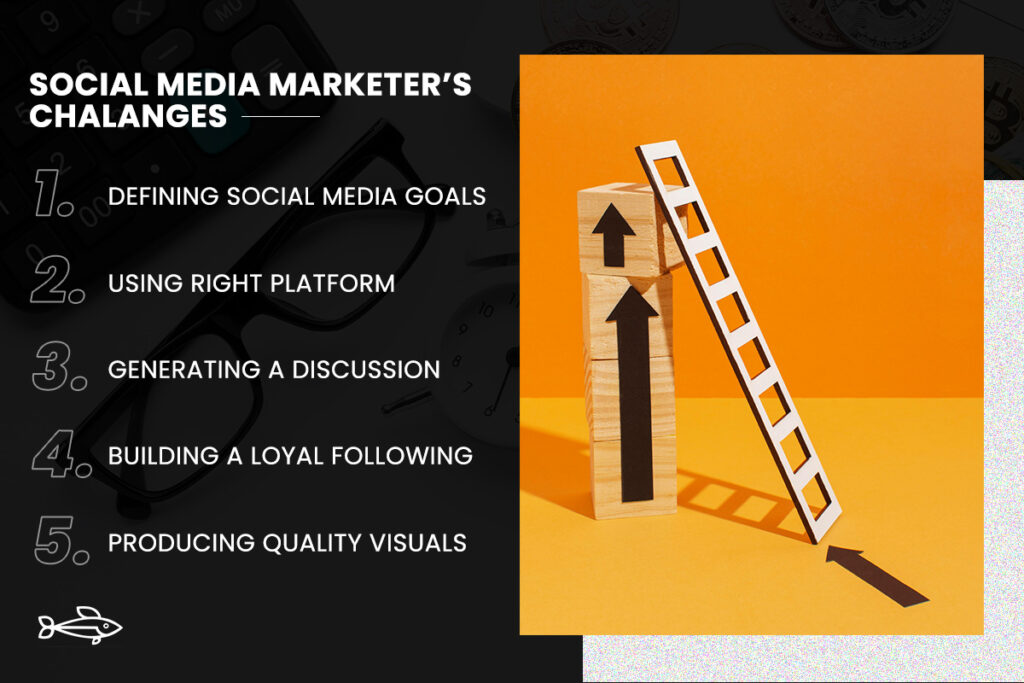
Social Media Marketing Challenges
Social media users increased by over 13% in July 2021 when people across the globe spent over 2 hours online. The increase in social media users and activity has prompted marketers to think outside the box to appeal to their audience. However, despite the spike in activity, engagement rates are declining. Branded content is at odds with social channel algorithms. While 73% of marketers consider social media marketing effective, a lot of them still struggle with their campaigns and strategies. As social media is constantly evolving, marketers are facing these pain points:
Defining Social Media Goals
Goal setting may sound basic but a lot of marketers are stuck in this part of the strategy. Brands are struggling to establish strategies that sync with their overall business goals. 47% cite goal-setting as their biggest bottleneck. It will be hard to measure your social media performance without clear goals. You cannot prove the value of your efforts to your stakeholders which may affect your budget for future campaigns.
Using the Right Platform
Working on the right platform can exhaust your budget and resources. Some marketers aren’t doing enough research to find where their target audience is most active. Take time to understand your audience, and learn about their genders, ages, locations, job titles, and interests. Your platforms are also tied up with your niche and industry. B2B brands can leverage LinkedIn and Google My Business whereas B2C companies need to bank on visual channels such as Pinterest, Facebook, and Instagram to attract your audience’s attention. Another way to determine which platforms you can benefit from the most is through social media listening. This will allow you to monitor brand mention of your competition. Determine the channels where they are generating attention and then map out your strategy on those platforms.
Generating a buzz
In the sea of attractive brands that actively compete against yours, how do you cut through the noise? Sparking interest and interactions on social media is undeniably one of the struggles that marketers encounter. Whether you are using paid or organic content, it’s taxing to vie for your audience’s attention. Modern consumers show less loyalty to brands that provide less than stellar customer service. 80% of consumers say the experience a brand delivers is just as important as its products and services.
Building loyal following
Shoppers are seeking genuine and personalized experiences from brands. They see right through a robotic voice and generic brand trying to drive their sales up. Hence, marketers struggle with connecting with their audience on a personal level. Genuine connection from brands is greatly rewarded with 72% of consumers saying they are more likely to buy from a brand that consistently provides a customized experience.
Producing Quality Visuals
Visual assets increase your chances of getting shared on social media. However, quality visuals take time and skills to design. More so, it’s a struggle to come up with visual assets that are compatible across all platforms.
Developing a solid social content strategy
There is no one-size-fits-all social media strategy that will guarantee success. Your strategy isn’t static either such that it should constantly adapt to trends, your audience needs, and marketing needs. Simply setting up a profile and posting randomly now and then is as good as not posting at all. Many businesses fail to see the importance of having a documented social content strategy and just try to wing their campaigns based on instinct and their available time.
Having a clear social media plan, a well-established content system, and a seamless workflow helps you grow your brand and fulfill your overall marketing goals.
How to create a content strategy
Establishing a content strategy can be overwhelming when you don’t know where to start. However, a documented content strategy yields great results in terms of a seamless process, clearer goals, progress tracking, and result measurement. More so, building a solid and failproof content strategy drives traffic, boosts sales and revenues, builds lasting relationships, and makes your brand a household name.
Stage 1: Review and Analysis
Evaluate Business Goals
Your goals will be your guiding path and will set your entire social media strategy. When a content strategy doesn’t work, it’s typically because of having mismatched goals. Take a step back to understand your brand, your competition, and what you’re trying to achieve. It pays to review these details as there are things that you might have missed out on and will come to light with fresh eyes. Assess any documents related to your business strategy. Revisit your business goals, brand positioning, and competition. Analyzing your competition is crucial to helping you distinguish your brand through personalized content. When you can determine messaging gaps in your niche and fill them, you’ll build the strongest connection with your audience. Your brand purpose, vision, mission, values, brand messaging, and visual elements should be reflected in your strategy for effective storytelling.
Now that you’ve revisited your business objectives, it is time to establish your social goals. A great goal-setting framework you can embrace is S.M.A.R.T or Specific, Measurable, Achievable, Relevant, and Time-Bound. This framework lets you establish well-defined campaigns, track your progress, and optimize your strategy for the long haul.
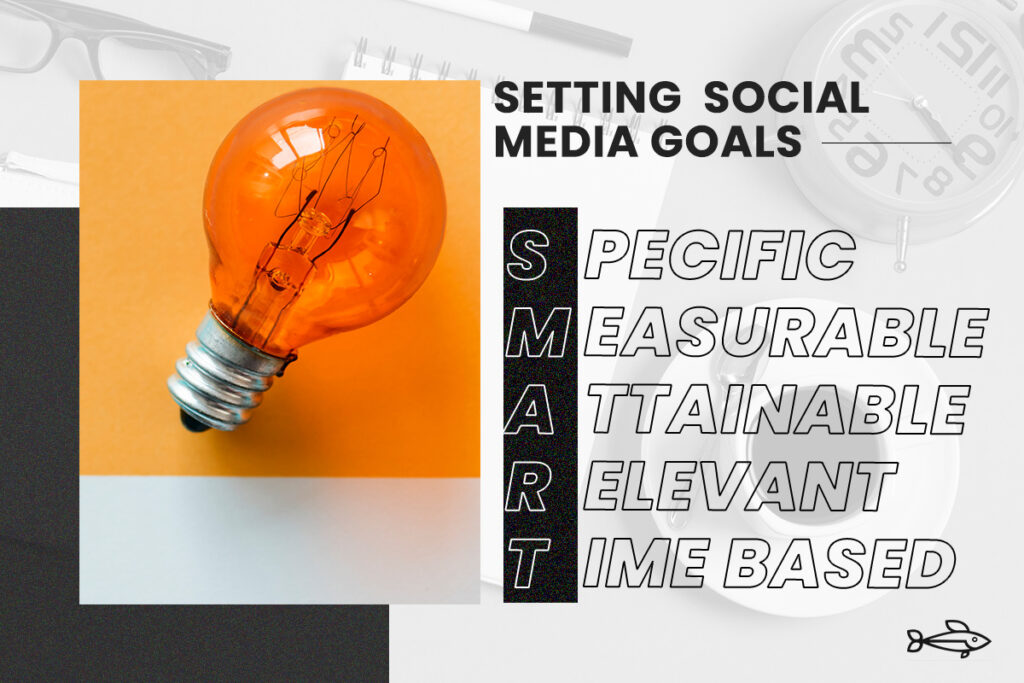
Crafting SMART Goals for Social Media Success
A vague goal is something like, “I will improve my number of followers on Facebook,” whereas a SMART goal says By the end of the month, I will increase my impressions on Facebook by 3%.
According to the Smart framework, your goals should be:
Specific – Simple, logical, and essential. The more specific you can be with jotting down your goals, the easier it is to find ways to achieve them.
Measurable – How will you keep track of your progress? Your goals should have metrics you can use to monitor results.
Achievable – High lofty goals can be exhausting and less plausible to achieve.
Relevant – Reasonable, realistic, and results-based. Do your goals support your overall branding and business objectives?
Time-bound – Give your goal a timeline and a deadline.
You must establish your expectations and specific goals from your social media plan. Set relevant metrics and KPIs to measure your progress and results. Doing so allows you to fine-tune your strategies.
Audit Your Content
Before distributing fresh new content, you must first understand what’s going on with your social channels. An audit gives you a comprehensive view of how social media helps your business. It is the process of analyzing and reviewing all the content on your website. The final goal is to uncover weaknesses and reveal strengths in your content creation and distribution workflow, and ultimately align your content plan to your existing marketing goals.
Track all your social accounts
Keep a record of all the accounts that you created and regularly use. Include old profiles you’ve created before you had a social strategy. Scour the web for possible accounts that your team might have forgotten. Impostor accounts might be stealing your fans. Use search engines and social networks to find possible accounts you have. Record all the necessary accounts you find and take note of accounts that need further research. These accounts can be profiles you are not sure whether an impostor manages it or someone from your team. Take notes of accounts you don’t own and find ways to take down these accounts. Reach out to the accounts or if things escalate, you can dispute it to the specific network.
Set up a social media monitoring program to track any new impostor accounts that may be set up in the future. This is also a prime time to determine platforms where you haven’t created a social presence. Then you can consider whether you need to set up a profile or just entirely leave it as it is.
Check all profiles to ensure they’re on-brand
Once you recorded all your profiles, check each one of them thoroughly to ensure it’s on-brand. Review each element against your brand guidelines to ensure each profile uses updated images, hashtags, keywords, brand voice and messaging, and other visual elements. Among the components you should check include:
- Profile and cover images. Are the profile and cover photos adherent to your current branding and the social networks’ required image size?
- Verification – Is your account verified? If not, work on getting a verification.
- Bio text – Make the most of your social bio and make sure it sums up who or what you are as a brand.
- Handle – Are all your social handles consistent across these profiles? It’s a great idea to be consistent if you can.
Pinned posts – Are your pinned posts still relevant, suitable, and up-to-date
Determine your best posts
Check the analytics of each network and find the top-performing posts in terms of the most engagement. Include links to these posts.
Understand the audience for each channel
The audience demographic is a good place to start. Understanding who you can reach through each channel allows you to customize your content for each type of audience.
Set goals for each channel
Decide what you want to improve on each platform. Consider what current strategies are delivering so you can capitalize on them. These goals should be aligned with your overall business objectives. Decide which channel you are keeping and which channels you are better off without. Think about ways you tie each account back to your social media marketing strategy. Are all these channels serving your purpose? If not, you might want to step back so you can focus your resources on channels that are converting.
Unclear social media goals translate to inconsistent, imbalanced, and ineffective content marketing. Defining your target gives you insights to establish a cohesive strategy and convey stories that connect with people.
Review your content tools
Managing your account across multiple channels can be complex and confusing. Using a stack of tools makes managing easier and more efficient. While these tools can be helpful, they can also be redundant. It’s essential to review your existing tools before creating a new strategy to find opportunities to cut costs, and determine new ownership, monitor subscription status to ensure the team has access. Reviewing your tools also informs you of the tools that you need. List down the tools and login details on the following:
- Landing page builder
- Blog
- Website and web analytics
- Content scheduling and publishing platforms
- Social media platforms and tools
- Content Management System
- Social listening tools
- Audience profiling tools
- SEO tools
- Visual design tools
- Email marketing tools
- Customer relationship management software
- Paid media channels and software
Some of these tools overlap depending on what you use. Once you track all your tools, ask yourself if they cover your needs. Do you have redundant tools that can be consolidated? Are all of these tools properly working? Are log-in details updated? Can people in your team access it? Do you have someone in your team proficient in each tool?
These tools are essential in supporting your team and your overall campaign.

Stage 2: Content Planning
When done right, content marketing offers an incredible opportunity to drive website traffic, attract leads, boost sales and revenue, and nurture clients. By delivering relevant content to your users, you can improve your brand reputation, grow a following, and inspire brand advocates.
A successful content marketing strategy should have brand positioning, value proposition, strategic plan, and business case. Moreover, brand positioning allows you to deliver a consistent experience for your audience and build the right image based on your branding.
By determining your existing and potential customers, their needs, your brand’s unique value, and your competition, you can find your brand positioning.
Value proposition
What unique value can you offer to your audience through your content? How do you cut through the noise and set your brand apart from the competition? You need to define your value proposition to establish your brand as credible. Research your target audience and determine what type of information they are searching for and their go-to resources.
Strategic Plan
This should be aligned with your goals and how exactly you will meet them. A strategic plan will help you evaluate each step of your strategy. It must help you determine your target audience for your content marketing, how you will deliver content for this audience, and how you will fulfill and measure targeted goals.
Content marketing vs content plan
Content marketing vs content planning are two different beasts. However, the content strategy provides a path to all of your marketing channels. Here, you outline all the varied marketing goals and how you plan to meet them. Subsequently, content planning comes after content marketing. It outlines all of the assets and data needed to meet the goals you established in your strategy. Ultimately, your content plan will serve as a guide to research, produce, upload, and monitor your content.
Record Your Content Strategy
Documenting your content strategy boosts your confidence in the effectiveness of your content marketing. A documented strategy lets you see the bigger picture and justify your overall content marketing budget. However, only a few understand the importance of documenting their content strategy because:
- Marketers don’t prioritize documenting their strategy
It is easier to just remember what you’ve discussed rather than take note of them. After all, who has the time? Between curating new content, and responding to your clients, you get swamped with tasks that will boost your marketing goals. However, the time you need to record your strategy is worth it considering the long-term benefits it offers for your strategy.
- There’s no point person or there are plenty of decision-makers
If you cannot pinpoint the person who will document your strategy or if there are plenty of decision-makers in your team, it can spell trouble. Either way, the best thing to approach this is to assign a person in charge of your content strategy. This person will be accountable and make the executive decisions when your stakeholders cannot decide.
- Marketers are clueless about where to start
While this is a common problem, it shouldn’t be an excuse not to document your strategy. Plenty of guides online such as ours can help you get started.

Create a Marketing Persona
Your content needs to reflect your audience’s interest no matter the platform. Also called a customer persona or audience persona, a marketing persona helps you target your ideal customer. It is a detailed description of someone who embodies your target audience. While fictional, your marketing persona is based on thorough research of your existing or desired audience. An audience persona serves as your foundation for all your marketing campaigns. How do you know which content will attract your target audience? Which platform should you optimize to reach your audience and build your brand? How should you talk to your audience on social media?
You need to provide a name, demographic details, purchase behavior, interests, pain points, goals, and other behavioral traits for your buyer persona. You want to speak about this model as if they were a real person to help you craft marketing messages customized for them.
Importance of a buyer persona
With buyer personas in mind, you can keep your voice and direction consistent with all your marketing campaigns. It makes you laser-focused on addressing their pain points. Each time you decide on your strategy, always think about your audience persona. You can create organic posts and customized social ads that speak directly to your target customers once you define your personas. When you establish your social strategy based on solving your persona’s pain points, you’ll foster a bond with the real customers.
Besides your traditional buyer, it also pays to check beyond your traditional buyer. Consider the following for your audience persona:
- Detractors – These are the other people who can disrupt your customers’ buying cycle.
- Influencers – While they may not purchase your product directly, they have the power to persuade your actual buyers. Hence, you must look into these people.
Negative personas – Defining people who aren’t your customers saves you time and resources. A negative persona sums up the people who don’t belong to your pool of paying customers. You don’t necessarily have to block people under your negative persona, it’s more on saying you aren’t dedicating your marketing efforts to attracting these people. Negative personas get a portion of your marketing budget which is why it is best to determine them at the early part of your strategy.
How to create an audience persona
Conduct thorough audience research
You need to understand the people who consume your content. Therefore, gather as much data on your target audience to understand them better, what they expect to see, and how you can get them to interact. This involves pulling out data from web analytics, surveys, and market research. Once you’ve gathered this information, compile audience data and narrow in on details including their age, location, language, purchase power and patterns, interests, pain points, stages of life, and the size of their business (for B2B). Additionally, find out which platforms are most active.
Knowing your target audience on a deeper level is an effective way to anticipate the type of content they want to see. Bear in mind that no specific content works across all platforms. If you are posting content across multiple channels, your content plan may have more than one audience type. You can also check which type of audience your competitions are targeting.
Determine your customer goals and pain points
Depending on what you offer, your audience’s goals may be personal or professional. Understand what motivates them. On the other hand, their pain points are what keep them from reaching their goals. What’s holding them back from reaching their goals? You can get insights from your sales team and customer support as well as through social listening and social media analytics. Social listening tracks conversations and mentions relevant to a topic on social channels. Through social listening, you can learn which parts of your customer service aren’t working as well as the reasons your customers love your products.
Offer solutions
Now that you have an understanding of your customers’ goals and challenges, it’s time to offer solutions. Think about how you can solve their pain points. Consider your customers’ main buying barriers and where they are in their buying journey. How can you help them? Write your answer concisely and clearly.
Create your buyer personas
Compile all your research and look for common characteristics of your buyer persona. You will have the foundation of your unique audience persona once you group those common traits. Give your customer persona a name, age, job title, interests, and other distinct characteristics. The goal is to make you’re personal seem like a real person. For example, say you identify the main customer group as 20-24 years old, Gen Z, condo-living professional women who have a passion for great coffee shops and dressing up. Your buyer persona might be “Chic Charlotte”
She is 23 years old.
She brews her coffee.
She lives in Downtown Manhattan and works as a social media manager.
She spends brunch on weekends with friends.
She attends spin class twice a week.
Defining your audience persona isn’t just enumerating their characteristics. It’s all about providing a detailed description of a potential customer to help you picture an actual buyer. As you refine your audience persona, describe who they are now and what they want to be. This will help you visualize how your products can help them reach their goals.
Map Your Customer Journey
Your buyers will go through a cyclical and multi-platform journey, which is why you must map their buying process. However, their journey isn’t linear, which is why it could be difficult to understand their needs and motivation. By creating a customer journey, which is a visual representation of customer interaction with your company, you can gain a grasp on their needs and issues that motivate or hold back their actions. Through mapping your customer journey, you can improve your service, resulting in higher conversation rates and increased customer retention.
Understanding your customer’s experience doesn’t just increase your revenue and minimize service costs, it helps you discover ways to be consistent in providing an exceptional customer experience. When done right, mapping customer journeys boosts customer engagement, determines and optimizes moments of truth in your customers, removes weak touchpoints, targets specific audience personas using campaigns related to their identity, and understands the challenges that may have resulted in irregularities in existing quantitative data.
What to include in your customer journey map
A journey map covers all touchpoints that your customer may have with your brand – from knowing your brand to direct interactions with your product. This includes all actions taken to arrive at your desired actions. When mapping out your customer journey, consider:
- The buying process – A customer journey map includes significant milestones in the customer journey. You’ll begin by drafting the path your business intends for a customer to take to reach a goal.
The five stages consumers undergo before making a purchase are:
- Attention: This is where brand awareness takes place.
- Interest: Where your audience starts gathering information about your brand.
- Desire: Your audience will start checking out competitions and other alternatives.
- Actual Purchase: At this point, you must make it as easy as possible for your customers to purchase your product or service. You don’t want to make it hard for them to buy when they’ve already made up their mind to do business with you.
- Post-Purchase: Everyone knows the best customers are the repeat customers. At this stage, your customers will evaluate their purchase and decide whether their experience is satisfactory or not.
- User actions – This specifies what your customer does in each stage of the buying process. Actions include consulting friends who tried your product or taking a trial version of your service. User actions explore the different ways your customers meet their needs.
- Emotions – Keep in mind that your customers are solving their pain points, which means they’re feeling certain emotions. Adding emotions to your customer journey allows you to reduce negative emotions about the journey so you don’t create a negative image of your brand.
- Pain Points – Knowing your customers’ pain points and adding them to your customer journey map allows you to determine which stage your customer is having negative emotions and find out why.
- Solutions – This final stage is where you and your team will come up with possible ways you can improve your buying process so your customers encounter fewer pain points. The goal is to create a positive experience for them to patronize your brand.
Customer Journey Touchpoints
Customer touchpoints are the key to knowing your customers’ journey. These touchpoints are the places where customers are directly and indirectly interacting with your brand. Moreover, customer touchpoints are essential in influencing the customer experience. It’s noteworthy that customers often form the first impression of a brand after seven interactions on average. Therefore, knowing your touchpoints and ensuring each of them provides a good customer experience should be your priority. By determining and mapping your customer touchpoints, you can build brand loyalty and improve customer experience.
Each touchpoint will impact your overall customer experience. Hence, you should have a clear idea about the touchpoints of your audience throughout their buying process. Based on that, you will have a better understanding of optimizing these touchpoints. A few of the tools you can optimize customer touchpoints include:
- Website
- Chatbots
- Live chat
- Customer Feedback
- Social media
- Events
- Display ads
- Newsletter
- Customer support
- Phone calls
- Product Demos
- Customer Loyalty Program
- Events
Since modern consumers are using different platforms to search for a brand, it pays to focus on the digital touchpoint to provide an outstanding customer experience. Having a deep touchpoint analysis helps you understand your customer preferences and expectations.
How to Map Out Customer Journey
No two customer journeys are the same but you can build on your map with this guide:
- Set clear goals – Why are you mapping your customer journey and for whom? You may want to create a buyer persona to remind you that you need to direct each stage of your customer journey towards them.
- Reach out to actual customers – Use questionnaires to survey people who are buying your product and services. These people have interacted with your company before or they have a plan to do so. A few questions you can include are:
- How did you hear about our company?
- What problems are you trying to solve?
- How long do you browse on our website?
- What appealed to you on our website?
- Did you purchase from us? If so, what made you buy them?
- On a scale of 1 to 5, how friendly is our website?
- Is our customer support helpful?
- Is there any way we can improve our process for you?
Focus on your target buyer personas
A customer journey map monitors the experience of a specific customer taking a certain journey with your brand. Don’t group too many personas in one journey since you will come up with inconsistent and inaccurate customer experiences. You should pick the most common customer persona and check the path they typically take when they engage with your brand for the first time.
Enumerate all the touchpoints
List out all the touchpoints your potential and existing customers are using. Include also the touchpoints you think they should be using. Whether they take a lot or fewer touchpoints, knowing your customer touchpoints enables you to improve your customers’ experience. Don’t just look at your website. Explore all how your customers can stumble on your brand. These touchpoints can be:
- Paid ads
- Email marketing
- Third-party review sites or brand mentions
- Press release
- Social Platforms
When listing your touchpoints, consider:
- Customer Actions
Write down all the actions your customers did while interacting with your brand. Actions can be searching on Google for your keywords or clicking your social media posts. You may come up with a long list of actions that you can whittle down to increase retention and conversion rates.
- Customer Emotions
These emotions will vary depending on where your customers are in their journey. For instance, what motivates your customers’ actions is typically caused by a problem. By having a deep understanding of your customer’s motivations and emotions, you can provide the right content at the right time for a smooth and seamless experience throughout their interactions with your brand.
- Customer pain points
Figure out what is stopping your customer from making their decisions or your desired action. An example is that your customers checked out your product but it turns out you have high shipping rates. Including these pain points in your customer journey allows you to alleviate them.
- Consider your resources
Your customer journey map will highlight all the resources needed to create a stellar customer experience. Hence, you must assess your current resources as well as the resources you will need to enhance the customer journey. Through your map, you can request investing tools that will help you meet your customers’ demands.
Test your customer journey map
Put your customer journey map to a test by taking it yourself. Put yourself in the shoes of your customer and find out the reasons for abandoned carts or the high bounce rate. Taking the journey lets you see where customers’ needs aren’t being fulfilled. More so, this allows you to provide valuable solutions for improved customer experience.
The data you gathered should give you an idea of how you can improve your website. Apply the necessary adjustments to enhance customer experience. Be it small or big adjustments, these changes are directly related to your customer’s pain points, which makes them effective. Review your customer journey regularly to determine roadblocks and gaps that hinder your customers from buying your products.
Choose the right distribution channel
Your content needs to be seen by the right people but with plenty of platforms available out there, which one should you use? Now that you have customer insights, it’s time to check the platform where they spend most of their time. Consider reviewing your Traffic Analytics tool to get insights about your monthly visitors, which channels drive the most traffic, and from which countries you’re generating this traffic.
To decide which platforms you should use, ask yourself first what your social media goals are. Are you eyeing boosting engagement? Nurturing your clients? Generating new traffic? Write down your goals so that everyone on your team understands the assignment. Fortunately, when you establish clear goals, finding the right channels becomes easier. Be specific when setting goals to make them more attainable.
The more you know your audience, the better you can provide customized content on the right channel. Consequently, your audience influences everything you do, including picking topics and content formats for your distributing channels. To gain deeper insights, refer to your audience persona. By being armed with these insights, figure out the sites they visit the most, the social platforms they are most engaged in, and the content format they consume.
Strategically Selecting Distribution Channels for Maximum Impact
With a deeper understanding of your audience, you can now come up with a list of all the platforms where you are most likely to distribute your content. Consider these categories:
- Owned: Refers to channels that belong to your brand such as website, blog, newsletter, and social media accounts.
- Earned: This is a free promotion including citations, fans or followers sharing your content, customer reviews, etc.
- Paid: A paid category is your sponsored ads, collaborations, and other media buys.
The goal is to focus on channels that will give you the most ROI. Once you’ve determined your main channels, specify platforms that will most likely meet your goals. Consider the platform that your audience spends most of their time online, the budget you set aside for distribution efforts, and the time needed to manage your campaigns. Some platforms require more resources to grow your following, interact with your audience, or meet your desired actions.
Determine your metrics
You need to determine whether your efforts are yielding results. Use your goal as the benchmark to identify your metrics. The better insights you’ll obtain from different channels when you use the right metrics. As we move along, we will tackle more about KPIs (Key Performance Indicators) and the important metrics you should use to monitor your progress and success.
Testing your channels
Testing your channels helps you gain audience insights and improve your results for specific campaigns. Focus on your priority channels first to get your bearings. Ensure that you are targeting the right audience before running your tests for a month. A month’s worth of data provides a wealth of information you can leverage for your strategy. Be attentive in monitoring your progress. If you don’t see any significant results, you can tweak your strategy so you can maximize your resources.
Your distribution channels aren’t set in stone. Revisit your channels regularly as these can change as your goals and business expand.

Consider the content formats
58% of consumers became interested in a brand after seeing them in Instagram stories whereas 50% went as far as purchasing after watching a product or service in a story. However, this doesn’t mean that you rely on images and videos alone. You can experiment with each content type and see which gets the most attention and engagement. The type of content will depend on your niche, the channel you’re using, and your target audience’s preferences. It’s a good idea to mix things up to stir interest until you determine the format that resonates with your audience the most. Once you start monitoring which content types get the most engagement, you can produce more of them. Try to use original photos as much as possible as this yields the most engagement.
Repurpose and Curate content
It’s not about fresh and new content, it’s all about how you use the content. Be it an old blog post or previous videos, there’s plenty of content you can repurpose for your audience. Dig through your old posts, take out valuable information from your blogs, and share it on social. If you have a listicle type of blog post, you can highlight each pointer in the list on Facebook or Instagram. You can also maximize the post by using carousels and story formats. On the other hand, when curating content from other sources, consider what’s trending in your niche, come up with striking graphics, and share it on your channels.
Establish an engagement plan
Engage your audience with user-generated content like #AskMeAnything sessions and relatable memes. Encourage interaction by asking for shares, retweets, or comments, and include clear calls to action. Hosting giveaways or promotions also boosts engagement. However, remember to align reposted user content with your brand to avoid confusion. Most importantly, actively engage with your audience by liking, commenting, and resharing their posts. This personal touch shows you’re listening and builds stronger connections.
Leverage on user-generated content
UGC or user-generated content is the bread and butter of social marketing. It’s an effective way to reach out to your audience organically. It refers to unpaid or unsponsored posts that people share across each platform when they talk about your brand. UGC is a killer asset wherein 55% of consumers rely on user-generated content over any other type of marketing. What’s more, is that 85% of consumers affirm that UGC is more influential content compared to branded content. UGC is an affordable way to build a loyal fan base and gain new traffic. However, when sharing content with your users, always err on the side of caution.
Avoid sharing content without reaching out and asking permission from the owner or properly giving them credit. Sharing without their consent kills the mood and defeats the purpose of building trust and loyalty with your followers. When you ask for their consent, you show your fans that you appreciate them and get them excited about sharing their post on their feed. This will also prevent you from facing copyright issues.
Be clear about the type of content you would most likely share. Creators want to know the exact type of content they can create that gets to be reposted.
Track your progress
When it comes to measuring results and tracking your progress, data doesn’t lie. Setting smart social KPIs will help you pay attention to the metrics that matter. But what social KPIs should you track? Your social media KPIs must be tied to your brand’s overarching goals. With ROI in mind, focus on reaching and engaging with qualified people. You should also keep an eye on your followers who are asking about what your offer is and how many of them turned into customers.
The four main areas that you need to monitor are engagement, reach, leads, and customers:
- Engagement: This measures the number of likes, shares, and comments on your posts. Additionally, a large reach with low engagement indicates that you aren’t sending the right message to your audience. Platforms such as Facebook and Twitter consider engagement as a sign of quality and popularity. Among the specific KPIs that need to be measured include clicks, likes, comments, shares, profile visits, and active followers.
- Reach: Reach indicates how your message has traveled and how much attention it’s gotten. You can measure reach by tracking your followers, checking your impressions, and gathering your traffic data.
- Leads: As your post gets traction, you can start tracking your leads. How many of your social followers have become your customers? If you aren’t generating leads you may be using the wrong platform or your content isn’t appealing to your audience.
Customers: They are the ultimate indicator of your success. If you’ve truly delivered the right message to the right people, they’ll be keen on purchasing your products or services. Pay attention to social channels that generate the highest and lowest customers. This will help you decide which platforms you need more focus on.

Build a content pipeline
Having a content pipeline lets you easily track all your leads and their content consumption behavior. A content pipeline is a systematic way to understand your prospects ‘consumption habits at each phase of their buying process. You decrease the quality of your content when you fail to optimize your content pipeline. Through the content pipeline, you can put first the content pieces that are preferred by your audiences. Before planning the exact content you need to create, you must determine the major milestones, events, or goals needed to build around. The 3 Ps of a content pipeline are:
- Preparation – This will set the tone of your entire strategy so make sure that you prepare adequately. Preparation involves the strategic choices you make early to determine your content purpose and direction. Your audience persona, keywords, and blog ideas are part of the preparation.
- Production – Failure to follow through with your preparation defeats its whole purpose. You need to define your content producers during production, the type of content, the title, and the content status.
- Publication – The final phase involves scheduling, actual publication, distribution, and analysis of completed content.
Fine-tune your content for each platform
Start filtering your content categories from your list of several ideas. First and foremost, ask yourself if your target audience will enjoy consuming this topic. You can then conduct a poll or survey to discover which content your target audience would love to hear from you. Upon completion of your poll, your content categories are ready. Subsequently, the next step is to determine what type of content you’d share per category. Among these content types may include a to-do list, tips and tricks, quotes, and branded content.
Assign workflow and responsibilities
Missed deadlines, off-topic content, and content pending approval can hold you back from succeeding in your campaigns. Your content workflow can make or break your social media marketing. A well-defined workflow makes content creation and distribution a smooth and seamless process.
A content workflow is the tasks that a person or your content team has to go through to complete a given piece of content. Part of your content workflow is defining the roles, responsibilities, and documentation of the different steps in the content creation process. With a well-laid-out content workflow, you can ensure that your content is accurate, cohesive, and on time. You also address common content pitfalls, inconsistencies, and mistakes and hold employees accountable for their content tasks.
The size of your team isn’t an indicator of the success of your social media campaigns. What matters is you have a team working and focusing on the same goals. This is why all your team members need to be on the same page when it comes to workflows and responsibilities.
Optimizing Content Workflow: Roles, Processes, and Tasks
At this point in your content strategy, you want to assign the roles and responsibilities to your team to hold them accountable and empower them to own up to their roles. The more people that are involved, the more likely people will work in silos, especially if you’re communicating with people outside your company. You can prevent this from happening by looking at your content workflow elements:
- Process: How does your content reach your audience online? Firstly, identify bottlenecks in its journey to improve efficiency. Next, speed and efficiency in content creation and publishing enhance relevance. It’s crucial to maintain quality, brand consistency, and approval workflow for effective digital marketing.
- Tasks: The tasks needed to ideate, produce, and distribute content are crucial to creating an efficient workflow. Write down all of the tasks that your team needs to complete to produce and distribute content. These tasks are dependent on your content format. Creating a video involves different tasks compared to producing a blog. Ensure that you repurpose your content across multiple channels to make the most of its value. Also, make sure you can see which tasks are completed and are still in progress so that you’re able to track the status of all tasks and determine possible loose ends.
- People: Your team plays a vital role in efficiently and effectively completing content. To this end, you need to ensure that everyone on your team is assigned to a role that maximizes their skillset, talent, and interests. Therefore, determine your team member’s strengths in terms of producing, editing, publishing, and distributing content. Moreover, don’t forget to consider your proofreaders and QA specialists to ensure quality and on-brand content.
Use the right tools
Content tools make your social media and content marketing life easier. Marketing your content is hard work but with the right set of tools, you can track your progress and calibrate your strategy whenever necessary. With the many incredible tools available online, it can be hard to choose which to use to help you succeed in your campaigns. Reflect on your goals, content workflow, and your team’s ability before choosing a tool. From there, you’ll have a solid set of criteria for selecting efficient tools. It pays to evaluate your tools regularly to ensure you’re using what you paid for.
Bringing the Creative
By now, you already know your goals and workflow. At this point, the decision-makers in your team have already approved your strategy. It’s time to figure out the creativity that will bring your ideas to life:
Elements of a Successful Content Marketing Campaign
Producing content isn’t rocket science; however, it needs time, energy, and resources to come up with appealing and entertaining content that will fulfill your marketing goals. Content creation is just the tip of the iceberg of a successful content marketing campaign. You also need to:
Ideate the right concepts
Quality content stems from providing value to your target audience. To do this, you need to focus on your audience persona and provide them with what they want.
Determine your main points
The right messaging ensures you are conveying a consistent story across all platforms. Avoid being too sales-y as it drives away your customers. Equipped with an understanding of your customer journey, you need to ensure you are sending the right messaging at each stage of their journey.
Decide the right format
The format is just as important as the message. Choosing the right medium helps you convey your messaging better, increases retention, and appeals to your target audience.
Know your SEO
Determine your focus keywords and how you can optimize your blogs and other content around them. Are your publishing channels SEO-friendly? The right keywords not only drive the right traffic and leads but also help you boost your ranking organically.
Establish your Editorial Calendar
An editorial calendar will keep everyone on your team on track with your publishing frequency. Content marketing strategy can be an overwhelming and complex task. By creating an editorial calendar, you put things into perspective and plan content that will support your campaigns. To build a content calendar, you must:
Identify your publishing frequency
Can you post once or twice a day daily? How about posting thrice a week? Planning your social content for a week can give you enough time to produce fresh and relevant content for your audience.
Include holiday and special observations
Besides inspiring content ideas, these events can disrupt your posting schedule.
Consider content format
Your content calendar needs to consider different formats as they involve different processes and production as well as add variety to your campaign.
Think about the people who will use the calendar
An effective editorial calendar lets multiple people brainstorm, collaborate, and offer feedback on assignments in real time — directly on the calendar.
Whether you are overhauling your content calendar or building it from scratch, you can take advantage of different editorial calendar formats and tools available online that will help you meet your team goals.

Executing your content strategy
Finally! Thanks to the thorough research and analyses you’ve done, you can now produce valuable content that matches your audience’s interest and intent. As you execute your strategies, don’t forget to:
Refine your content production
Your content production process isn’t linear. There are plenty of moving parts when it comes to producing compelling content. Producing content can get complex depending on your goals, the content format, and the channels you plan to distribute them.
Stick to your deadlines
Following your timelines keeps you consistent. Give yourself time to conceptualize, produce, and communicate with your team. Ensure you get approvals at each phase of content creation to avoid last-minute changes that will throw you off your deadline.
Establish an effective distribution strategy
A stellar piece of content becomes pointless when it’s not distributed to the right audience. Through an effective distribution strategy, you get to maximize your reach and boost the value of your content.
Your content strategy isn’t set in stone. It must be flexible to accommodate changes as you gather audience insights along the way. A documented content strategy lets you monitor your progress, track your success, and gather insights. If your strategy doesn’t deliver your desired results, you become more adept at tweaking your campaigns and adjusting your focus. As your brand evolves, so will your content strategy. This is why it is important to revisit your strategy regularly to ensure it still aligns with your brand goals.







